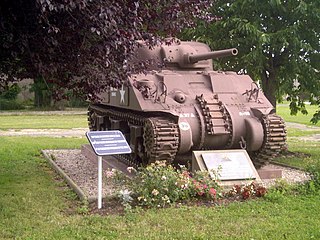Explanation of title
As written by the volume's author:
Precise military terminology has been employed, except in those cases where clarity and economy of style have dictated usage of a more general nature. Thus, the Third Army operations in Lorraine are considered to be a "campaign" in the general sense of the term, despite the fact that the Department of the Army does not award a separate campaign star for these operations. [1]
Although the term Lorraine Campaign is unofficial, it represents a more traditional use of the term "campaign" in that the battles described by the term were part of a larger operation that had a set goal. By contrast, the official U.S. Army campaign names refer to what were actually multiple campaigns and large military organizations with diverse goals.
Operationally, the term encompasses the assaults across the Moselle and Sauer Rivers, the battles of Metz and Nancy, and the push to the German frontier and the crossing of the Saar/Sarre River during the first half of December 1944.

The Moselle is a river flowing through France, Luxembourg, and Germany. It is a left tributary of the Rhine, which it joins at Koblenz. A small part of Belgium is also drained by the Moselle through the Sauer and the Our.

The Sauer or Sûre (French) is a river in Belgium, Luxembourg and Germany. A left tributary of the Moselle, its total length is 173 kilometres (107 mi).
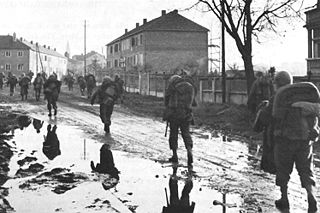
The Battle of Metz was a battle fought during World War II at the city of Metz, France, from late September 1944 through mid-December between the U.S. Third Army commanded by Lieutenant General George Patton and the German Army commanded by General Otto von Knobelsdorff. Strong German resistance resulted in heavy casualties for both sides. The city was captured by U.S. forces and hostilities formally ceased on 22 November; the last of the forts defending Metz surrendered on 13 December.
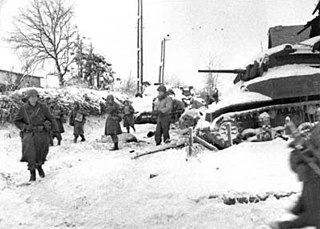
The Battle of the Bulge, also known as the Ardennes Counteroffensive, took place from 16 December 1944 to 25 January 1945, and was the last major German offensive campaign on the Western Front during World War II. It was launched through the densely forested Ardennes region of Wallonia in eastern Belgium, northeast France, and Luxembourg, towards the end of the war in Europe. The offensive was intended to stop Allied use of the Belgian port of Antwerp and to split the Allied lines, allowing the Germans to encircle and destroy four Allied armies and force the Western Allies to negotiate a peace treaty in the Axis powers' favor.
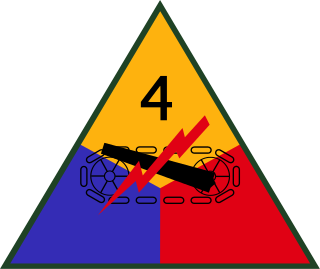
The 4th Armored Division was an armored division of the United States Army that earned distinction while spearheading General Patton's Third Army in the European theater of World War II.

The Battle of the Ardennes was a battle of the First World War fought on the frontiers of France, Germany, Belgium and Luxembourg from 21 to 23 August 1914. The German armies defeated the French armies and forced the French armies to retreat. The battle was part of the larger Battle of the Frontiers, the first battle of the Western Front.

The 10th Armored Division was an armored division of the United States Army in World War II. In the European Theater of Operations the 10th Armored Division was part of both the Twelfth United States Army Group and Sixth United States Army Group. Originally assigned to the Third United States Army under General George S. Patton, it saw action with the Seventh United States Army under General Alexander Patch near the conclusion of the war.

Operation Nordwind was the last major German offensive of World War II on the Western Front. It began on 31 December 1944 in Rhineland-Palatinate, Alsace and Lorraine in southwestern Germany and northeastern France, and ended on 25 January 1945.

The Allied advance from Paris to the Rhine, also known as the Siegfried Line Campaign, was a phase in the Western European Campaign of World War II.

Plan XVII was the name of a "scheme of mobilization and concentration" that was adopted by the French Conseil Supérieur de la Guerre from 1912–1914, to be put into effect by the French Army in the event of war between France and Germany. Though it was not "a prescribed narrative for the campaign" or battle plan, the deployment made possible a prompt invasion of Germany and/or Belgium before Germany could mobilise its reserves, simultaneous to a Russian invasion of East Prussia. The plan was implemented from 7 August 1914, with disastrous consequences for the French, who were defeated in the Battle of the Frontiers (7 August – 13 September) at a cost of 329,000 casualties. The French northern armies were forced into a retreat as far as the Marne river, where in the First Battle of the Marne (5–12 September), the German armies were defeated and forced back to the Aisne river.

The Battle of the Frontiers was a series of battles fought along the eastern frontier of France and in southern Belgium, shortly after the outbreak of the First World War. The battles resolved the military strategies of the French Chief of Staff General Joseph Joffre with Plan XVII and an offensive interpretation of the German Aufmarsch II deployment plan by Helmuth von Moltke the Younger. The German concentration on the right (northern) flank, to wheel through Belgium and attack the French in the rear, was delayed by the movement of French Fifth Army towards the north-west to intercept them and the presence of the British Expeditionary Force (BEF) on his left flank. The Franco-British were driven back by the Germans, who were able to invade northern France. French and British rearguard actions delayed the German advance, allowing the French time to transfer forces on the eastern frontier to the west to defend Paris, resulting in the First Battle of the Marne.
The 6th Panzer Army was a formation of the German Army, formed in the autumn of 1944. The 6th Panzer Army was first used as an offensive force during the Battle of the Bulge, in which it operated as the northernmost element of the German offensive. The army was subsequently transferred to Hungary in early 1945 and used in both offensive and defensive actions there. The final battles of the 6th Panzer Army were fought in Austria until the collapse of Nazi Germany, at which point the army was completely demoralized. The remnants of the army eventually surrendered to the United States Army. Army commander throughout the army's existence, SS-Oberstgruppenführer Josef Dietrich said in early 1945:
"We call ourselves the "6th Panzer Army", because we've only got 6 Panzers left".

The XII Corps fought from northern France to Austria in World War II. Constituted in the Organized Reserves in 1933, it was activated on 29 August 1942 at Columbia, South Carolina. XII Corps became operational in France as part of Lieutenant General George S. Patton's Third Army on 1 August 1944. Initially commanded by Major General Gilbert R. Cook, bad health forced MG Cook to relinquish command to Major General Manton S. Eddy within three weeks. MG Eddy commanded the corps until late April 1945, when his own health problems forced him to turn over command to MG Stafford LeRoy Irwin.
Hugh Marshall Cole was an American historian and army officer, best known as the author of The Lorraine Campaign and The Ardennes: Battle of the Bulge, two volumes of the U.S. Army official history of World War II.
The Wehrmacht forces for the Ardennes Offensive were the product of a German recruitment effort targeting German males between the ages of 16 and 60, to replace troops lost during the past five months of fighting the Western Allies on the Western Front. Although the Wehrmacht was keeping the Allied forces contained along the Siegfried Line, the campaign had cost the Wehrmacht nearly 750,000 casualties, mostly irreplaceable. However, the rapid advance of the Allied armies in August and September after Operation Overlord had created a supply problem for the Allies. By October, the progress of the Western Allies' three army groups had slowed considerably, allowing the Germans to partly rebuild their strength and prepare for the defense of Germany itself. Adolf Hitler, the German leader, decided that the only way to reverse his fortunes would be to launch a counter-offensive on the Western Front, forcing both the United States and Great Britain to an early peace, and allowing the Wehrmacht to shift its forces to the Eastern Front, where it could defeat the much larger Soviet Red Army.
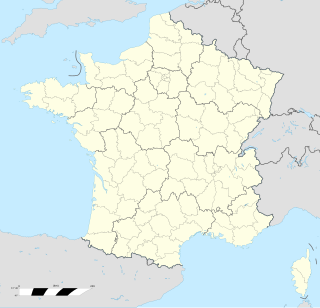
The Fort de Saint-Julien, renamed Feste Manteuffel in German, is a military installation near Metz. It is part of the first fortified belt forts of Metz and had its baptism of fire in late 1944 in the Battle of Metz.

The Feste von Zastrow, renamed Fort des Bordes by the French in 1919, is a military structure located in the district of Boric in Metz. It is part of the first fortified belt of the forts of Metz. Buried since the construction of the Eastern expressway in 1968, it is covered by a green space, although some remnants of the fort remain visible.

The Feste Wagner, renamed Group Fortifications of Aisne by the French in 1919, is a fort of the second fortified belt of forts from Metz, in Moselle. This group fortification, built in the municipalities of Pournoy-la-Grasse and of Verny, controlled the valley of the Seille. It had its baptism of fire in late 1944, when the Battle of Metz occurred.

The Feste Mercy, renamed Feste Freiherr von der Goltz in 1911 and then The Group Fortification Marne in 1919, is a military installation near Metz, in the woods between Jury, Mercy and Ars-Laquenexy. It is part of the second fortified belt of forts of Metz and had its baptism of fire in late 1944, when the Battle of Metz occurred.

The Feste Haeseler, renamed Group Fortification Verdun after 1919, is a military installation near Metz. Constituted as forts Sommy and Saint-Blaise, the fortified group is part of the second fortified belt of forts of Metz. It had its baptism of fire in late 1944, when the Battle of Metz occurred.

The Feste Prinz Regent Luitpold, renamed Group Fortification Yser after 1919, is a military installation near Metz. It is part of the second fortified belt of forts of Metz and had its baptism of fire in late 1944, when the Battle of Metz occurred.









